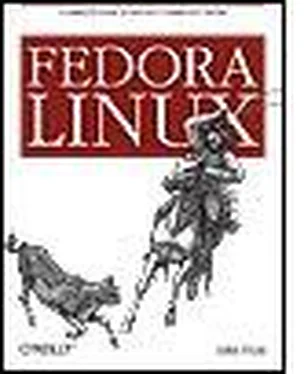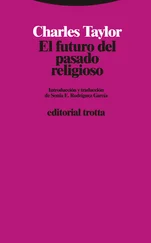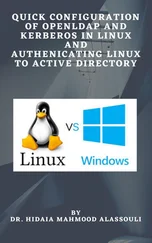Some download tools have problems with files over 2 GB in size. Most of the time, these problems affect only the download size, progress, or time-remaining displays during the download process, but some versions of the Lynx browser will not successfully download files over 2 GB. Older versions of wget also have a 2 GB limitation. If you are downloading onto a Windows system that is formatted with the FAT file system, the maximum file size may be 2 GB (FAT16) or 4 GB (FAT32).
To download only the boot disk ISO (for use with a network or hard disk installation):
Go to the web page http://fedora.redhat.com/Download/mirrors.html and select an HTTP or FTP site for direct download. Select the directory for the desired Fedora Core version number (6), then the directory for your machine architecture (i386, PPC, or x86_64), select the os directory, and then select the images directory. Download the file named boot.iso . (You can also find this file in the images directory of the Fedora Core DVD or CD disc 1).
Once you have the image files, burn them onto optical media using the CD-creator program available on the platform used for downloading. For example, on Windows you could use Nero or Roxio Easy Media Creator; on a Linux system (such as Fedora Core 4), right-click on the file and select "Write to disc," or use a tool such as K3B , xcdroast , or growisofs .
When burning a CD or DVD, use the ISO image file as the disc filesystem, but do not place the ISO image inside another filesystem on the disc. You will usually get the correct results if you save the ISO file to the desktop and then double-click on it.
To verify that the disk was created correctly, open it after you burn it: you should see several files and directories. If you see a single file with a .iso extension, the disc was not created correctly.
1.2.1.4. Buying Fedora Core CDs or DVDs
Depending on the speed of your Internet connection, it may be faster and cheaper to purchase a set of Fedora discs than to download the software. A list of online Fedora Core vendors is available at http://fedoraproject.org/wiki/Distribution/OnlineVendors , and a list of local retailers carrying Fedora Core is at http://fedoraproject.org/wiki/Distribution/LocalVendors .
1.2.1.5. Preparing files for a hard disk installation
To install Fedora Core from a FAT, ext2, or ext3 partition, simply copy the ISO image files for the DVD or CD set onto that disk partition. For example, on a Windows system with a FAT32 disk partition D: , download the DVD image file as though you were going to burn it onto a DVD but place the image file on drive D: (be sure to record the name of the directory/folder containing the images!).
1.2.1.6. Preparing a USB flash disk, network installation server, or PXE boot server
Each of these tasks is most easily performed on a running Linux system; see Chapter 10 for instructions. (Similar software is available for other platforms.)
An ISO image file is an exact copy of the contents of an optical disk. The name comes from the fact that data on optical discs is stored using a standard known as ISO 9660 .
Each type of boot media has a unique standard for specifying how boot data is stored. On optical discs, the El Torito standard permits the system BIOS to find the boot software. For USB disks, a standard hard disk boot sector is used. For PXE network booting, a boot protocol (bootp) server is used to identify the boot files, and a trivial file transfer protocol (TFTP) server is used to serve them to the client system.
The first piece of software that loads from the boot media is the bootloader: isolinux for optical discs, syslinux for USB flash drives, or pxelinux for PXE boot servers.
After accepting boot parameters from the user, the bootloader subsequently loads two files:
vmlinuz
A compressed Linux kernel; the heart of the Fedora Core operating system.
initrd.img
A filesystem image that is loaded into memory and used as a ramdisk. This provides the drivers, startup scripts, and programs to get the system started.
Once these files have been loaded, the kernel is executed and begins the install process.
1.2.3.1. ...installing from a floppy disk?
The Fedora installer has grown to the point that it no longer fits on a floppy disk. The USB flash disk method has replaced the floppy-disk boot procedure.
1.2.4. Where Can I Learn More?
The Fedora Core release notes: http://fedora.redhat.com/docs/release-notes/ or in the root directory of Fedora Core CD disc 1 or DVD
The Fedora Core installation guide: http://fedora.redhat.com/docs/fedora-install-guide-en/
Documentation on syslinux , isolinux , and pxelinux : http://syslinux.zytor.com/
Burning ISO images to CD/DVD: http://www.linuxiso.org/viewdoc.php/howtoburn.html
Fedora on Macintel: http://fedoraproject.org/wiki/FedoraOnMactel
1.3. Installing Fedora Core
Installing Fedora Core is a simple and straightforward task on most modern computers.
To install Fedora Core, you'll need the installation media and your computer. If you are going to use a local area network or broadband Internet connection, it's recommended that you have it connected during the installation process.
A Fedora installation will usually take 15 to 90 minutes, depending on the speed of your computer and the amount of optional software you choose to install.
1.3.1.1. Preparing for dual-boot
If your system already has Windows installed, and you intend to continue to use Windows, you will need to free up some space on the hard disk for Fedora Core. See Lab 10.1, "Resizing a Windows Partition ," for instructions on shrinking a Windows disk partition (or deleting one that is unused).
There is an alternative to repartitioning your disk: you can install an additional disk drive in your system and use that drive for Fedora, or use an external USB or FireWire drive.
Be sure to check the system requirements in the release notes at http://fedora.redhat.com/docs/release-notes/ or in the root directory of the Fedora Core DVD or CD disc 1.
On your system, if you have any data that you want to preserve, back it up before installing Fedora Core, and test the integrity of the backup copy.
1.3.1.2. Starting the installation
Insert your installation media (DVD, CD, or USB stick, or plug your system into a network with a PXE network boot server) and turn your system on. If it does not boot from the installation media, change your system BIOS settings to boot from it.
The first thing you will see is the boot screen shown in Figure 1-1 .
Figure 1-1. Fedora Core installation boot screen

The boot: prompt at the bottom of the screen lets you configure special options. You can press Enter for a standard, graphical installation, or you can type linuxfollowed by any of the keywords in Table 1-3 to specify particular options for the installation session. Table 1-4 lists hard disk device names.
Additional installation boot options are discussed in Chapter 10.
Читать дальше













